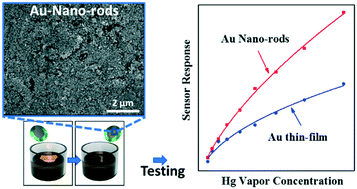Gold nanorod self-assembly on a quartz crystal microbalance: an enhanced mercury vapor sensor†
Abstract
It is now well documented that mercury is extremely toxic to both humans and the environment. A close-packed gold nanorod (Au-NR) monolayer was deposited on a titanium-based quartz crystal microbalance (QCM) and its performance for elemental mercury (Hg0) vapor sorption and detection was compared with that of a typical gold thin film (Au CTRL) based QCM device. The developed Au-NR based Hg0 sensor showed an up to ∼1.7 times higher response magnitude than its Au CTRL counterpart when exposed to Hg0 vapor concentrations of 0.21 to 3.26 mg m−3 at two different operating temperatures of 30 and 75 °C. The repeatability of the Au-NR sensor was calculated to be >90% when exposed to a series of sorption/desorption events with a Hg0 vapor concentration of 3.26 mg m−3. The calibration curves (i.e. response magnitudes vs. Hg0 concentrations) of the Au-NR sensor were found to follow the Langmuir extension isotherm, indicating the sensor's suitability to detect relatively low concentrations (ppb levels) of Hg0 vapor. Furthermore, the newly developed Au-NR sensor showed good selectivity (∼97%) toward Hg0 vapor when acetaldehyde co-existed in the gas mix. However, the selectivity of the sensor decreased to 66% and 67% when Hg0 vapor was detected in the presence of ammonia and water vapor, respectively. The selectivity data from the tested sensors were analysed to understand the selectivity performance of Au NRs toward Hg0 vapor in the presence of different gas species in order to implement improvements in developing the sensor for real world applications.



 Please wait while we load your content...
Please wait while we load your content...